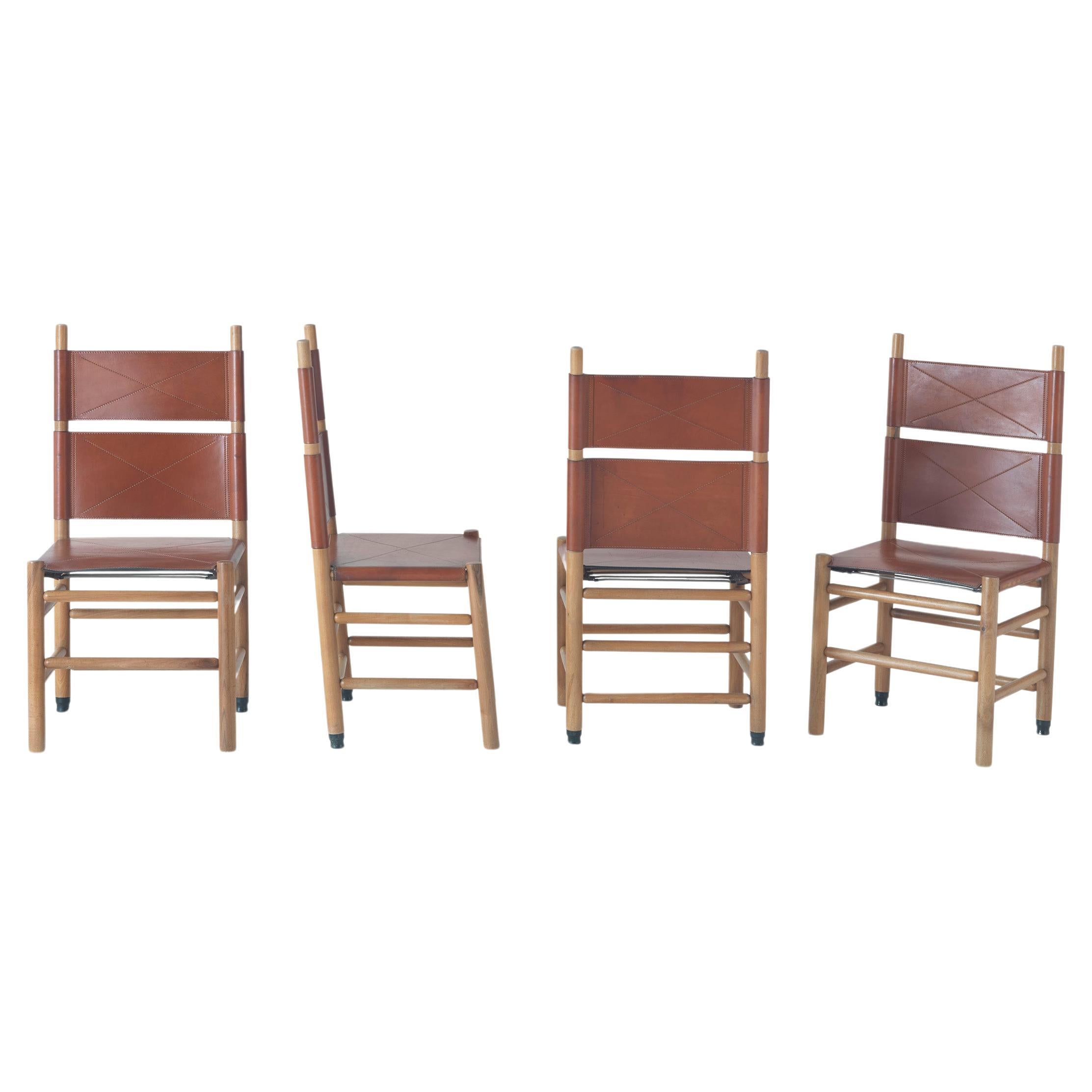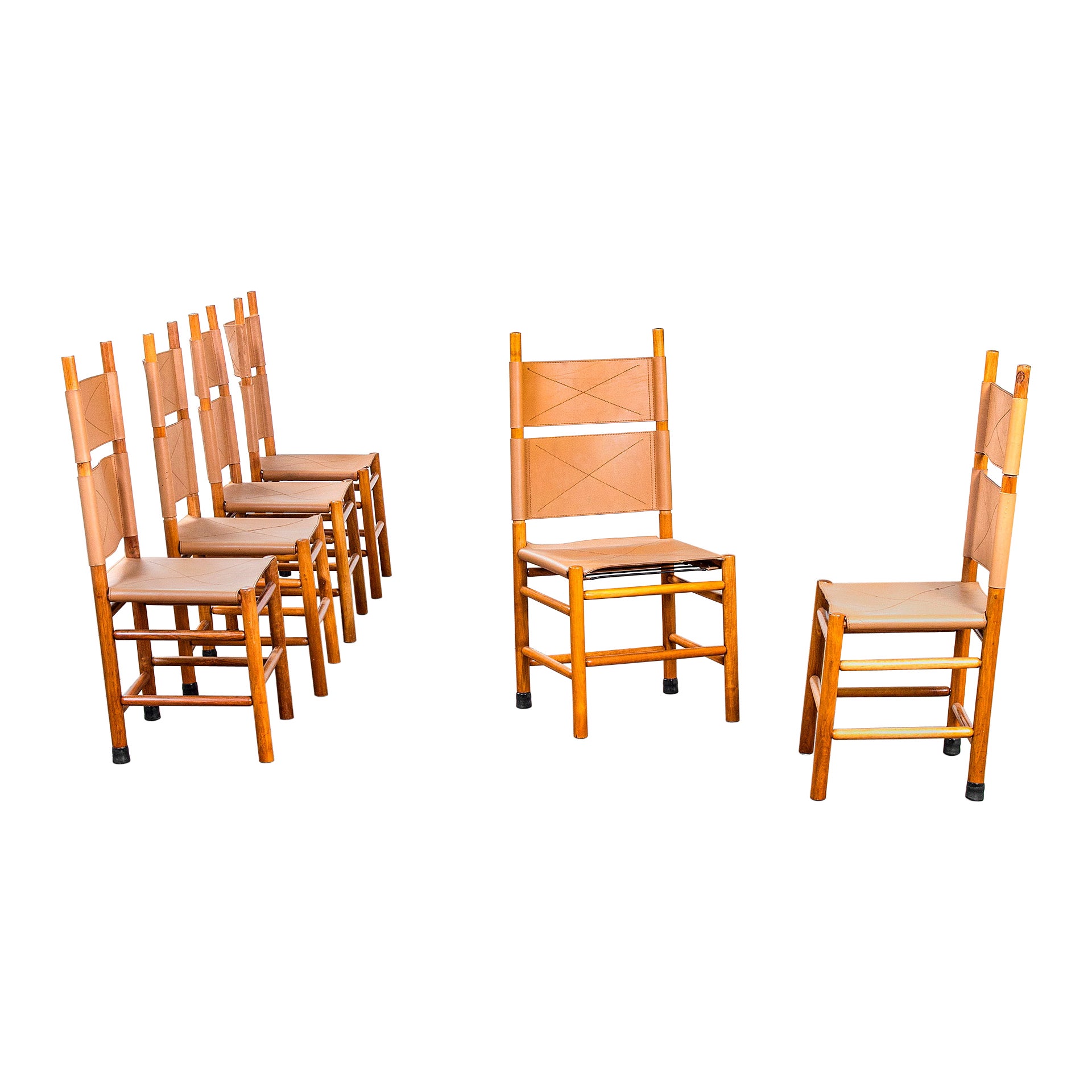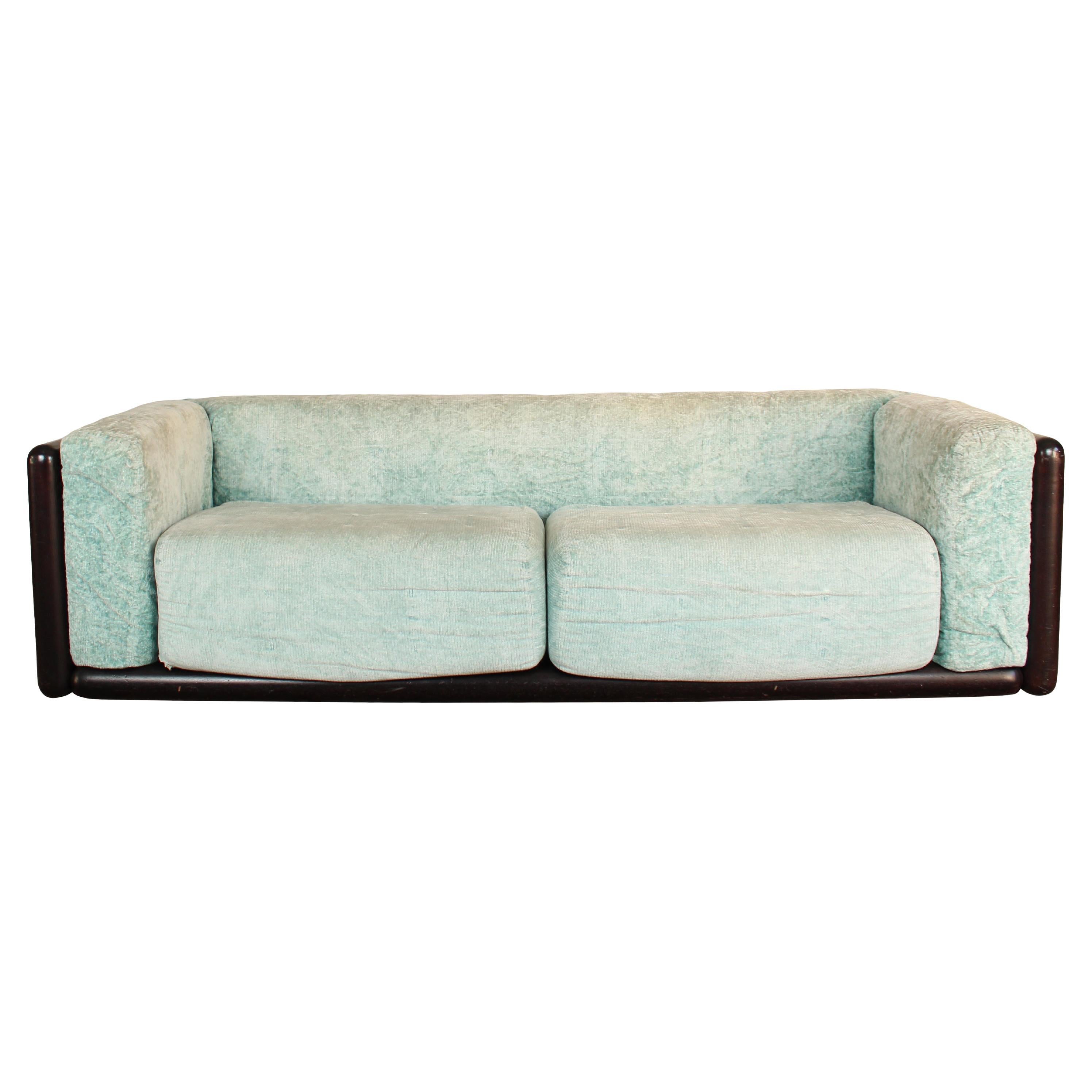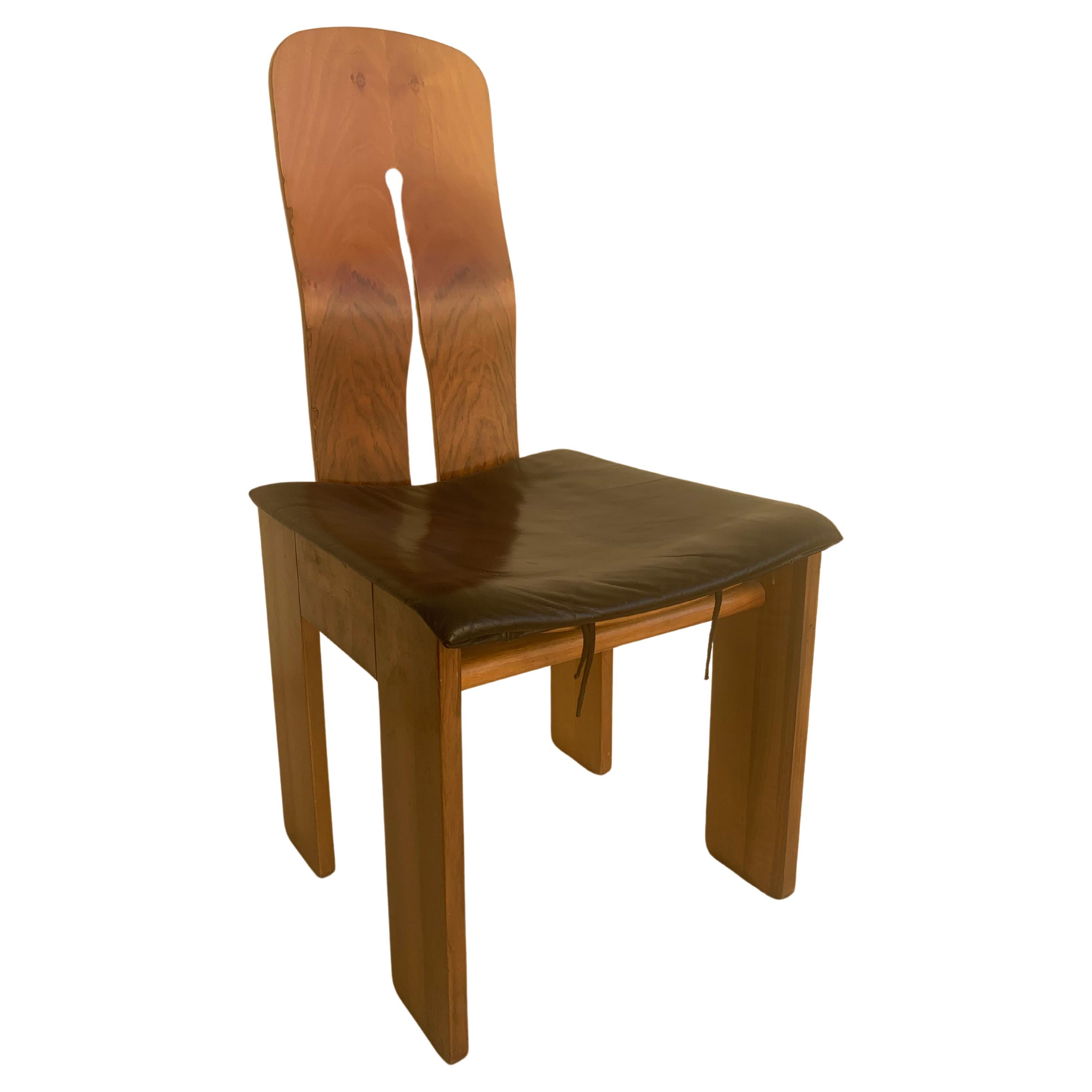Items Similar to Set of 4 chairs Carlo Scarpa, Bernini mod. 1934-765
Want more images or videos?
Request additional images or videos from the seller
1 of 10
Set of 4 chairs Carlo Scarpa, Bernini mod. 1934-765
About the Item
This Is a rare iconic set of 4 chairs design by Carlo Scarpa for Bernini, mod 1934-765.
This chairs Born in 1970, and come up in original condition, without any restoration as in photo, with his awesome walnuts wood.
This sculptural chair Is perfect for luxury house design, with a look into art and architetture, as well as the designer Carlo Scarpa the italian iconic master .
- Creator:Carlo Scarpa (Designer)
- Design:
- Dimensions:Height: 95 in (241.3 cm)Width: 43 in (109.22 cm)Depth: 41 in (104.14 cm)Seat Height: 43 in (109.22 cm)
- Sold As:Set of 4
- Style:Brutalist (Of the Period)
- Materials and Techniques:
- Place of Origin:
- Period:
- Date of Manufacture:1977
- Condition:Minor losses.
- Seller Location:Montecchio Precalcino, IT
- Reference Number:1stDibs: LU7454236009452
About the Seller
No Reviews Yet
Vetted Seller
These experienced sellers undergo a comprehensive evaluation by our team of in-house experts.
1stDibs seller since 2022
- ShippingRetrieving quote...Ships From: Montecchio Precalcino, Italy
- Return PolicyThis item cannot be returned.
More From This SellerView All
- Set 4 Cassina VillaBianca chairs by Vico MagistrettiBy Vico MagistrettiLocated in Montecchio Precalcino, VIRare set of 4 "VillaBianca" chairs design by italian master Vico Magistretti for luxury brand Cassina. This Amazing set Is perfect for 80s lovers, Memphis style, plastic space age ro...Category
Vintage 1980s Italian Post-Modern Living Room Sets
MaterialsPolyester, Hardwood
- Applique Flos mod. Foglio by Afra e Tobia ScarpaBy Afra & Tobia ScarpaLocated in Montecchio Precalcino, VIVery First edition of Flos Foglio by Afra e Tobia Scarpa. This Is an absolutly italian Classic art, design by Tobia Scarpa, he wrapped a sheet in his studio,and do the same with a me...Category
Vintage 1980s Italian Mid-Century Modern Wall Lights and Sconces
MaterialsMetallic Thread
- Floor lamp Mazzega mod. Canne, design by Carlo NasonBy Carlo NasonLocated in Montecchio Precalcino, VIThis Is a rare Mazzega floor lamp, mod. Canne, design by murano master Carlo Nason . His legendary works with sfumato glass Is known as one of the best Murano artist, with awesome wo...Category
Vintage 1960s Italian Mid-Century Modern Floor Lamps
MaterialsMetallic Thread
- Carlo Nason Mazzega pendant FazzolettoBy Carlo Nason, MazzegaLocated in Montecchio Precalcino, VIPrestigious Murano glass pendant designed and created by Carlo Nason for Mazzega. The classic handkerchief design recalls the Murano tradition, the iridescent glass, thick, and wit...Category
Vintage 1970s Italian Mid-Century Modern Chandeliers and Pendants
MaterialsArt Glass, Murano Glass
- Floor lamp Artichoke Mazzega design Carlo NasonBy Carlo Nason, MazzegaLocated in Montecchio Precalcino, VIVery rare Mazzega floor lamp model artichoke designed by maestro Carlo Nason for Mazzega in the 1960s. The lamp is composed of various Murano glass panes, worked to fit one on top of...Category
Vintage 1960s Italian Mid-Century Modern Floor Lamps
MaterialsIron
- Carlo Nason Mazzega Murano big Wall lampBy Carlo Nason, MazzegaLocated in Montecchio Precalcino, VIOriginal 1960/70 Mazzega Big Wall lamp by Murano master Carlo Nason. This Is an artistic building glass block with and Amazing Sfumato finish, Chai...Category
Vintage 1960s Mid-Century Modern Wall Lights and Sconces
MaterialsGlass
You May Also Like
- Carlo Scarpa "1934" Dining Chair for Bernini, 1977, set of 6By Carlo Scarpa, BerniniLocated in Lonigo, VenetoCarlo Scarpa "1934" dining chair for Bernini, walnut and reddish brown leather, Italy, 1977, set of six. Initially designed for Scarpa's own Venetian house in 1934, this model came up to production only in 1977. This chair demonstrates his architectural attitude toward furniture design. The sophisticated and right-angled base contrasts with the backrest essentiality, further enriched by its curvaceous shapes. A remarkable detail is an open cut on the back that diverges at the bottom, resulting in an unusual yet genuine form. Although an apparent disharmonic look is created, these details enhance the chair's elegance. We can do custom restoration and special reupholstering. Our atelier guarantees the excellence of Italy through the traditional art of craftsmanship. We do offer a dedicated customization service thanks to our team of expert craftsmen and artisans. Contact Modernab Gallery...Category
Vintage 1970s Italian Mid-Century Modern Chairs
MaterialsLeather, Walnut
- Carlo Scarpa Iroko and Velvet Cornaro Sofa for Studio Simon, 1974, Set of 2By Studio Simon, Carlo ScarpaLocated in Vicenza, ITSet of 2 Cornaro two-seater sofas, designed by Carlo Scarpa and manufactured by Studio Simon in 1974. Made of Iroko wood, foam, and azure chenille velvet. Excellent vintage conditi...Category
Vintage 1970s Italian Mid-Century Modern Living Room Sets
MaterialsChenille, Velvet, Foam, Wood
- Kentucky chairs by Carlo Scarpa for Bernini, 1977By Carlo ScarpaLocated in Misinto, ITKentucky is a chair born from the collaboration between Carlo Scarpa and the Bernini company. It exhibits apparent formal simplicity but actually conceals a highly articulated and de...Category
Vintage 1970s Italian Dining Room Chairs
MaterialsWalnut, Leather
- 20th Century Carlo Scarpa Set of Six Chairs mod. KentuckyBy Carlo Scarpa, BerniniLocated in Turin, TurinCarlo Scarpa (1906- 1978) was an Italian architect and designer heavily influenced by the history of Venetian culture, materials and landscape. in 1926 obtained his diploma of Profes...Category
Vintage 1970s Italian Mid-Century Modern Chairs
MaterialsFaux Leather, Wood
- Carlo Scarpa Iroko Wood and Green Velvet Cornaro Sofa for Studio Simon, 1974By Carlo Scarpa, Studio SimonLocated in Vicenza, ITCornaro two-seater sofa, designed by Carlo Scarpa and manufactured by Studio Simon in 1974. Made of Iroko wood, foam, and azure chenille velvet. Excellent vintage condition. Born in Venice on June 2nd, 1906, Carlo Scarpa began working very early. Only a year after he had first qualified as an architect in 1926, he began working for the Murano glassmakers Cappellin & Co. in a consultative capacity; from 1927, he began to experiment with the Murano glass, and this research not only gave him excellent results here but would also inform his progress for many years to come. Between 1935 and 1937, as he entered his thirties, Carlo Scarpa accepted his first important commission, the renovation of Venice’s Cà Foscari. He adapted the spaces of this stately University building which stands on the banks of the Grand Canal, creating rooms for the Dean’s offices and a new hall for academic ceremonies; Mario Sironi and Mario De Luigi were charged with doing the restoration work on the frescos. After 1945, Carlo Scarpa was constantly busy with new commissions, including various furnishings and designs for the renovation of Venice’s Hotel Bauer and designing a tall building in Padua and a residential area in Feltre, all worth mentioning. One of his key works, despite its relatively modest diminished proportions, was the first of many works which were to follow in the nineteen fifties: the [bookshop known as the] Padiglione del Libro, which stands in Venice’s Giardini di Castello and shows clearly Scarpa’s passion for the works of Frank Lloyd Wright. In the years which were to follow, after he had met the American architect, Scarpa repeated similar experiments on other occasions, as can be seen, in particular, in the sketches he drew up in 1953 for villa Zoppas in Conegliano, which show some of his most promising work. However, this work unfortunately never came to fruition. Carlo Scarpa later created three museum layouts to prove pivotal in how twentieth-century museums were set up from then on. Between 1955 and 1957, he completed extension work on Treviso’s Gipsoteca Canoviana [the museum that houses Canova’s sculptures] in Possagno, taking a similar experimental approach to the one he used for the Venezuelan Pavilion at [Venice’s] Giardini di Castello which he was building at the same time (1954-56). In Possagno Carlo Scarpa was to create one of his most incredible ever works, which inevitably bears comparison with two other museum layouts that he was working on over the same period, those of the Galleria Nazionale di Sicilia, housed in the Palazzo Abatellis in Palermo (1953-55) and at the Castelvecchio in Verona (1957- 1974), all of which were highly acclaimed, adding to his growing fame. Two other buildings, which are beautifully arranged in spatial terms, can be added to this long list of key works that were started and, in some cases, even completed during the nineteen fifties. After winning the Olivetti Award for architecture in 1956, Scarpa began work in Venice’s Piazza San Marco on an area destined to house products made by the Industrial manufacturers Ivrea. Over the same period (1959-1963), he also worked on renovating and restoring the gardens and ground floor of the Fondazione Querini Stampalia in Venice, which many consider one of his greatest works. While he worked on-site at the Fondazione Querini Stampalia, Carlo Scarpa also began building a villa in Udine for the Veritti family. To shed some light on how much his work evolved over the years, it may be useful to compare this work with that of his very last building, villa Ottolenghi Bardolino, which was near completion at the time of his sudden death in 1978. Upon completion of villa Veritti over the next ten years, without ever letting up on his work on renovation and layouts, Scarpa accepted some highly challenging commissions which were to make the most of his formal skills, working on the Carlo Felice Theatre in Genoa as well as another theatre in Vicenza. Towards the end of this decade, in 1969, Rina Brion commissioned Carlo Scarpa to build the Brion Mausoleum in San Vito d’Altivole (Treviso), a piece he continued to work on right up until the moment of his death. Nevertheless, even though he was totally absorbed by work on this mausoleum, plenty of other episodes can offer some insight into the final years of his career. As work on the San Vito d’Altivole Mausoleum began to lessen in 1973, Carlo Scarpa started building the new headquarters for the Banca Popolare di Verona. He drew up plans that were surprisingly different from the work he carried out simultaneously on the villa Ottolenghi. However, the plans Carlo Scarpa drew up, at different times, for a monument in Brescia’s Piazza della Loggia commemorating victims of the terrorist attack on May 28th, 1974, make a sharp contrast to the work he carried out in Verona, almost as if there is a certain hesitation after so many mannered excesses. The same Pietas that informs his designs for the Piazza Della Loggia can also be seen in the presence of the water that flows through the Brion Mausoleum, almost as if to give a concrete manifestation of pity in this twentieth-century work of art. Carlo Scarpa has put together a highly sophisticated collection of structures occupying the mausoleum’s L-shaped space stretching across both sides of the old San Vito d’Altivole cemetery. A myriad of different forms and an equally large number of different pieces, all of which are separate and yet inextricably linked to form a chain that seems to offer no promise of continuity, arising out of these are those whose only justification for being there is to bear the warning “si vis vitam, para mortem,” [if you wish to experience life prepare for death] as if to tell a tale that suggests the circle of time, joining together the commemoration of the dead with a celebration of life. At the entrance of the Brion Mausoleum stand the “propylaea,” followed by a cloister that ends by a small chapel, with an arcosolium bearing the family sarcophagi, the central pavilion, held in place on broken cast iron supports, stands over a mirror-shaped stretch of water and occupies one end of the family’s burial space. The musical sound of the walkways, teamed with the luminosity of these harmoniously blended spaces, shows how, in keeping with his strong sense of vision, Carlo Scarpa could make the most of all his many skills to come up with this truly magnificent space. As well as an outstanding commitment to architectural work, with the many projects we have already seen punctuating his career, Carlo Scarpa also made many equally important forays into the world of applied arts. Between 1926 and 1931, he worked for the Murano glassmakers Cappellin, later taking what he had learned with him when he went to work for the glassmakers Venini from 1933 until the 1950s. The story of how he came to work on furniture design is different, however, and began with the furniture he designed to replace lost furnishings during his renovation of Cà Foscari. The later mass-produced furniture started differently, given that many pieces were originally one-off designs “made to measure.” Industrial manufacturing using these designs as prototypes came into being thanks to the continuity afforded him by Dino Gavina, who, as well as this, also invited Carlo Scarpa to become president of the company Gavina SpA, later to become SIMON, a company Gavina founded eight years on, in partnership with Maria Simoncini (whose own name accounts for the choice of company name). Carlo Scarpa and Gavina forged a strong bond in 1968 as they began to put various models of his into production for Simon, such as the “Doge” table, which also formed the basis for the “Sarpi” and “Florian” tables. In the early seventies, other tables that followed included “Valmarana,” “Quatour,” and “Orseolo.” While in 1974, they added a couch and armchair, “Cornaro,” to the collection and the “Toledo” bed...Category
Vintage 1970s Italian Mid-Century Modern Living Room Sets
MaterialsVelvet, Foam, Chenille, Wood
- Carlo Scarpa Walnut and Black Leather Chairs for Bernini, Italy, 1977By Carlo Scarpa, BerniniLocated in Sacile, PNCarlo Scarpa walnut and black leather chairs mod. 1934/765 for Bernini, 1977. 765 is planned by Carlo Scarpa in 1934, year from which the chair will ta...Category
Vintage 1970s Italian Mid-Century Modern Dining Room Chairs
MaterialsLeather, Walnut
Recently Viewed
View AllMore Ways To Browse
Walnut Living Room
765 Italy
Chairs Sitting Set Of 2
Rattan Table With Ottoman
Louis Xvi Parlor Set
Beige French Living Room Sets
Austrian Animal Skin Living Room Sets
Split Reed Bamboo Chairs
20th Century Canvas Living Room Sets
Pretzel 5 5
Red Italian Living Room Sets
6 Strand Pretzel
North American Wicker Living Room Sets
Salon Suite Louis Xiv
Vintage 5 Piece Rattan Bamboo
3 Piece Parlor Set
Antique 3 Piece Parlor Set
Orange Italian Living Room Sets





